My Perfect DIY Walking Route for 1 Day in Salzburg (based on my own experience)

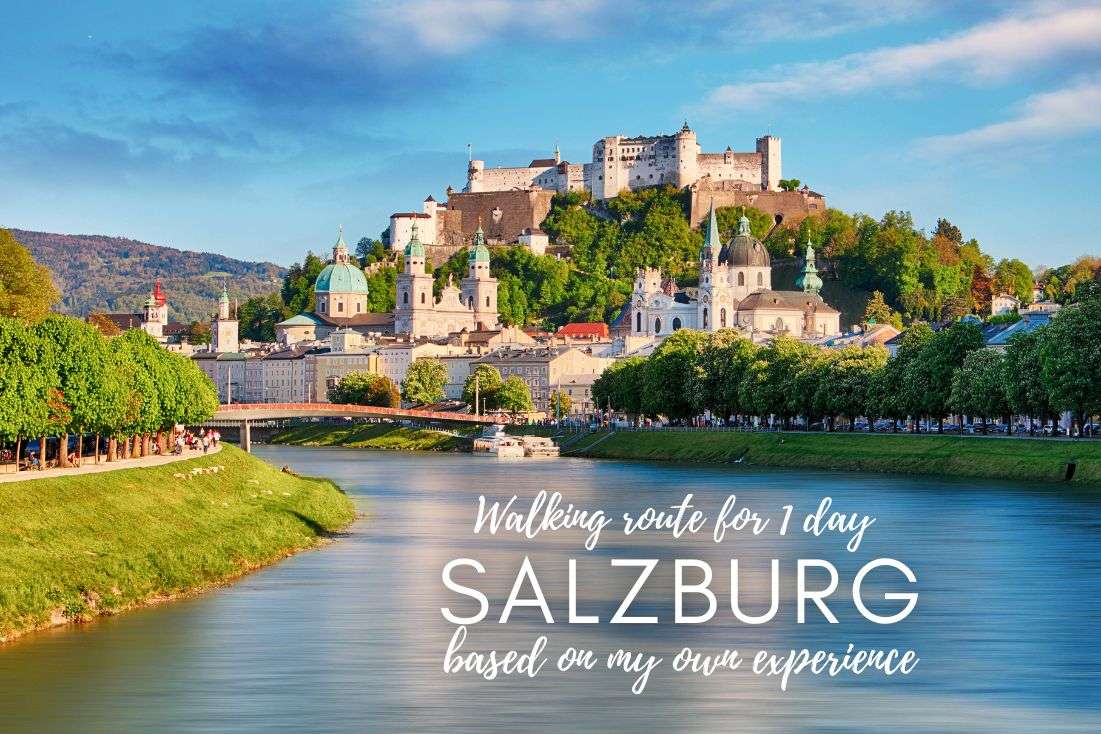
Is Salzburg worth visiting? If you’re anything like me, you’ve probably wondered if this small Austrian city is more than just a Mozart-and-Sound-of-Music shrine. The short answer: Yes—for a day.
Salzburg is compact, packed with history, and stunningly well-preserved, but let’s be honest, it’s not the most thrilling destination in Austria (read more about Austria). That said, if you’re passing through or planning a day trip, it’s worth stopping by to see the best of it.
In just one day in Salzburg, you can:
- Walk through a perfectly preserved Old Town (UNESCO-listed)
- Climb up to a medieval fortress with 360° city views
- Check out Mozart’s birthplace and the house he wrote music in
- Visit baroque palaces, trick fountains, and even a beer museum
- Discover a futuristic glass dome packed with planes, Formula 1 cars, and flying machines—and then have a Michelin dinner there.
To save you time and unnecessary detours, I’ve put together the ultimate one-day itinerary covering Salzburg’s 7 must-see attractions. Whether you’re here for a quick stop or trying to make the most of your Austrian trip, this guide will show you exactly what’s worth seeing—and what’s skippable.
Want to see it all efficiently? I’ve structured this list in a logical sightseeing order, so you won’t waste time zigzagging across the city.
Let’s get started!
Sometimes, all you need to do is take the first step... I've filtered out the best hotels in Salzburg for you
Save it for yourself to come back to later, or share with your friends on social media!
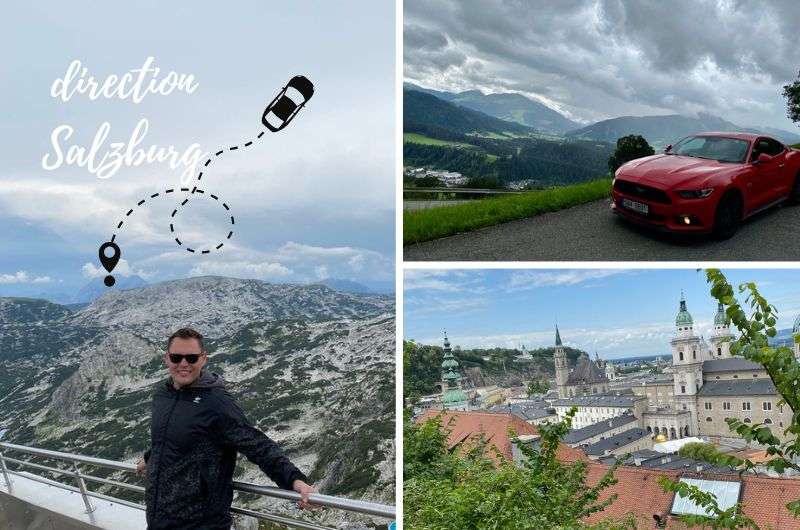
Driving through Austria never gets old... Every turn brings a new stunning view. Who else loves road trips there?
One-day Salzburg itinerary: quick overview
- Morning: Old Town stroll (max. 2 hours) with Mozart’s Birthplace and Museum of Modern Art or Mirabell Gardens
- Midday: Hohensalzburg Fortress (1.5 hours, including walk to get there)
- Afternoon: Hellbrunn Palace & trick fountains (1.5 hours)
- Evening: Hangar 7 & dinner (2+ hours)
- Have more time? Add Salzburg Zoo and Stiegl-Brauwelt beer experience
- Best hotels in Salzburg: Small Luxury Hotel Goldgasse | Hotel Goldener Hirsch
Now that you’ve got the big picture of how to spend a day in Salzburg, let’s move on to the details.
Map of your DIY walking tour of Salzburg
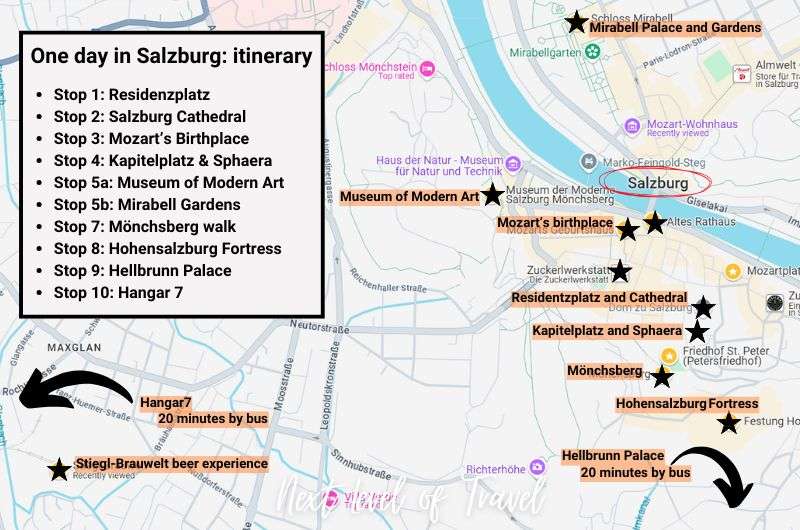
You can cover all of Salzburg’s highlights in a day, but I’ll add extra options if you have more time than that
Here are Salzburg’s must-see sights, listed in the best sightseeing order to maximize your time and avoid unnecessary backtracking. I’m only including things that aren’t tourist traps because, wow, you’ll be surprised by how everything screams at you to visit because of Mozart.
Pro tip: Salzburg is very walkable, but a few attractions (like Hellbrunn Palace and Hangar 7) are best reached by car or taxi.
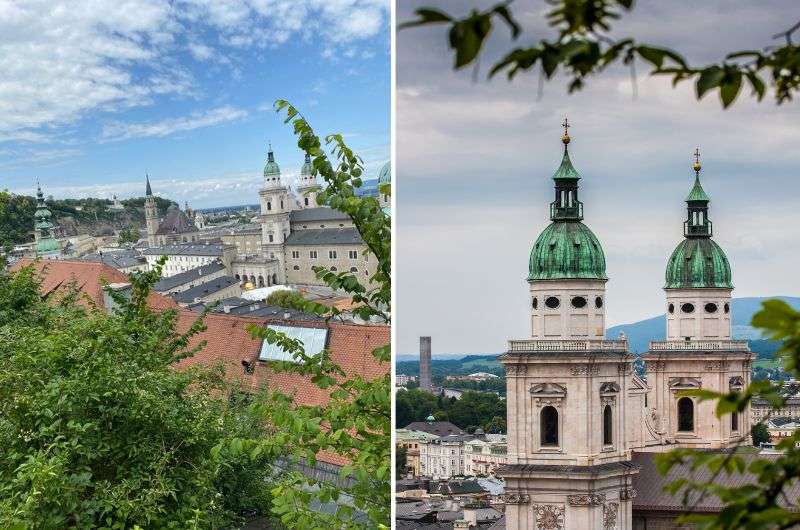
Start in the Old Town and work your way up to the fortress. Here @ Cathedral of St. Rupert and Virgil
Let’s start in the heart of the city—Salzburg’s beautifully preserved Old Town.

1. Start early and explore Salzburg’s Old Town (with Mozart’s birthplace)
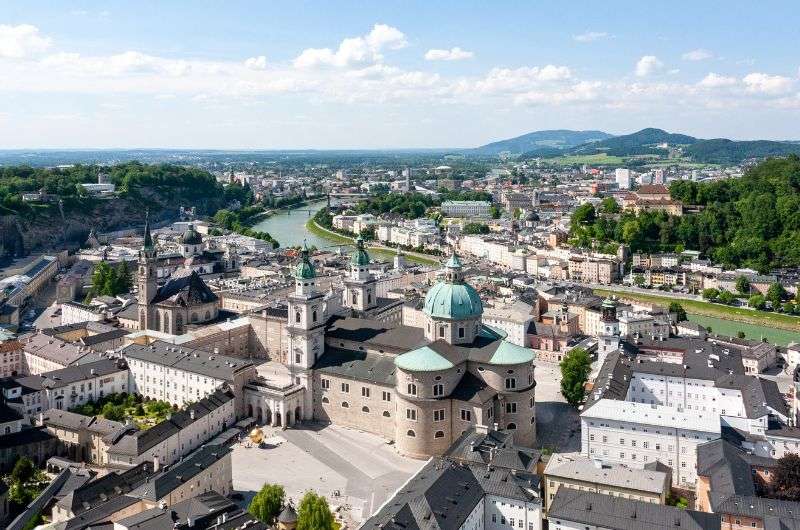
Take a walk through Salzburg's old town
Lucky for you, most of Salzburg’s historical landmarks and famous squares are packed into one area: the Old Town (Altstadt). This UNESCO World Heritage Site is pretty, with its baroque churches, medieval alleys, and grand palaces all within walking distance.
I’ll be honest—I wasn’t that impressed. Maybe that’s because I’m from Prague, where we have grander palaces, more impressive old streets, and even better baroque architecture on every corner. Anyway, here’s what you can see in Salzburg's Old Town:
Begin your walk in Residenzplatz
My tip: If you want to cover the must-see spots quickly, do what I did and head straight to Residenzplatz (Residence Square), the heart of it all. The highlights:
- Salzburg Cathedral: The massive baroque cathedral where Mozart was baptized. (Yes, that Mozart—Salzburg will make sure you don’t forget him.)
- DomQuartier & Alte Residenz: Former residence of the prince-archbishops, now an extravagantly decorated museum that screams “wealth and power.” If you like your ceilings gold-plated and your staircases grand, you’ll like this place.
- Neue Residenz & Glockenspiel: Home to the Salzburg Museum and its 35-bell carillon, which chimes classical melodies at 7 am, 11 am, and 6 pm.
- St. Peter’s Monastery, Cemetery, and Catacombs: One of Salzburg’s oldest sites, with rock-carved catacombs and an eerie but beautiful cemetery. If you squint really hard, it might remind you of a scene from The Sound of Music.
- A true gem for Christmas fans or children: Salzburger Weihnachtsmuseum. A small Christmas museum (a 30-minute visit max) with a historical collection of Christmas decorations, toys, and various Christmas-related items.
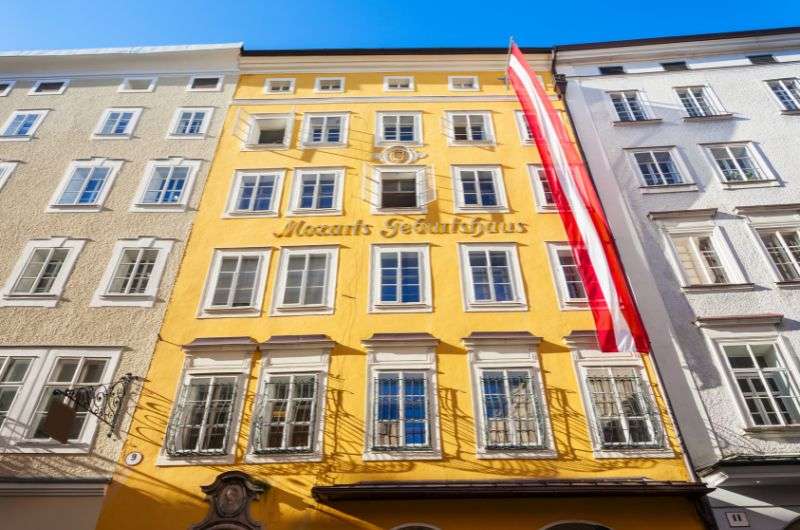
Mozart everywhere. His birthplace is a must for fans, but for most, a quick photo will do
Mozart’s Birthplace—The most overhyped spot in Salzburg?
If Salzburg had a mascot, it would be Mozart. His face is everywhere—on chocolates, souvenirs, and even beer. It got old very fast.
I went to see the most famous Mozart-related spot, Mozart’s Geburtshaus (Mozart’s Birthplace) on Getreidegasse. This is where young Wolfgang Amadeus Mozart was born in 1756, and the museum inside is devoted to his early life, family, and musical genius.
If you’re a die-hard Mozart fan, you might love it. Otherwise, just take a quick look at the bright yellow building from the outside and keep walking like I did.
Something quirky: Kapitelplatz & the Giant Golden Sphere
As I continued wandering, I stumbled upon Kapitelplatz, home to the famous “Sphaera”—a massive golden ball with a man standing on top, created by artist Stephan Balkenhol. If you’re wondering what it means, join the club. No one knows.
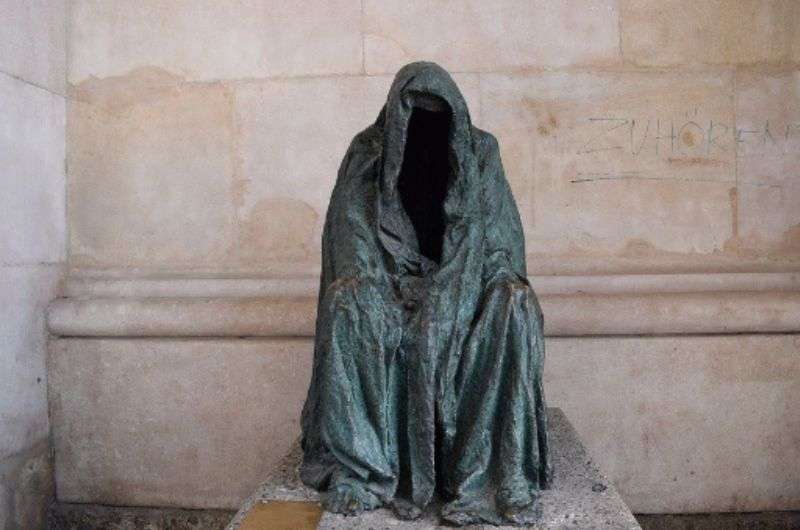
Il Commendatore aka Nazgûl
A hidden gem for LOTR fans
Salzburg has its fair share of sculptures, but for Lord of the Rings fans (yeah, I’m one of them) there’s one I couldn’t miss: a Nazgûl lookalike right in front of the Salzburg Cathedral. Officially, it’s called Il Commendatore and represents a character from Mozart’s Don Giovanni.
2. Take the funicular up to the Museum of Modern Art, even if it’s just for the views
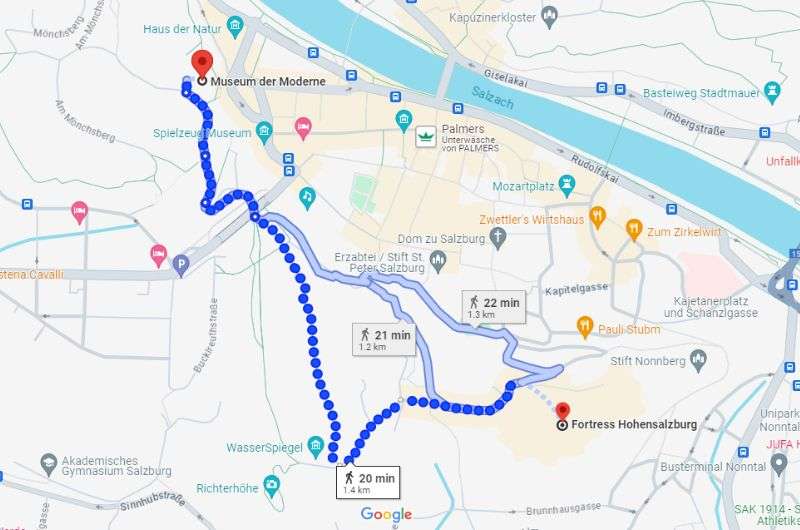
A pleasant walk from the Museum of Modern Art to the Hohensalzburg Fortress. Here is the route on Google Maps
One of the unexpected highlights of Salzburg for me was the Museum of Modern Art, perched on Mönchsberg, high above the city rooftops. You don’t have to be a modern art intellectual to enjoy it (I’m not either), but I strongly recommend getting up there—if only for the view.
There are two ways up:
- Hike up A scenic trail past old city walls and watchtowers, a reminder that Salzburg wasn’t always about Mozart and marzipan. This route takes 20–30 minutes, depending on how much you stop to admire the views.
- Take the lift: If walking uphill sounds like a medieval punishment, the Mönchsberg Aufzug (elevator) whisks you to the top in seconds. You’ll find it at Gstättengasse 13, right under the hill, about a 7-minute walk from Mozart’s Birth house.
Once at the top:
- The view over Salzburg is spectacular—arguably one of the best panoramas in the city.
- I grabbed a drink at the bistro on the terrace.
- If you like modern art, the museum itself is worth checking out—rotating exhibitions focus on contemporary Austrian and international artists. I opted for just the views this time around.
A hidden bonus: The perfect walk to Hohensalzburg Fortress
The art museum is inside a large park that connects it to Hohensalzburg Fortress via a pleasant 30-minute walk, which I thoroughly enjoyed. If you’re not in a rush, this is a fantastic way to reach the fortress without taking the funicular.
Practical Info:
- Free with Salzburg Card
- Check current exhibitions & opening times on the official website
3. …or check out Mirabell Palace & Gardens instead
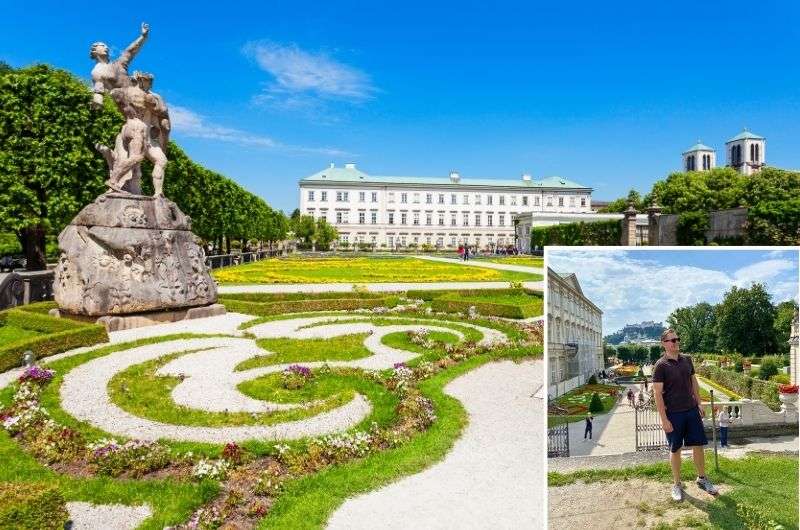
Wonderful Mirabell Palace
Across the Salzach River, just a short walk over the bridge, I visited Mirabell Palace and its famous gardens. If you love baroque architecture and manicured landscapes, this is a dream. If you don’t, well… you might wonder why people make such a fuss about it. I saw it. It’s nice, but I can’t say you’d miss out a ton if you can’t fit it into your itinerary.
Disclaimer: I’m putting this attraction on the list because I get that people love it, even though I don’t. If you only have one day in Salzburg, you won’t have time to see everything on this list, so treat this stop as an alternative to the Museum of Modern Art or another spot that doesn’t quite pique your interest. Or just take a quick peek and move on (it’s free).
Want a good photo? The Mirabell Gardens seem to have one major selling point—everyone wants that perfectly framed photo of Hohensalzburg Fortress in the background. But again, I think there are much better spots in Salzburg for photo ops, like Kapitelplatz or the Modern Art Museum, both mentioned above.
Not a Baroque fan? Here's why you might still enjoy Mirabell:
- It’s free, so at least you’re not paying for another fancy palace.
- It’s in the middle of everything—an easy, no-detour stop between other sights.
- The Sound of Music was filmed here—if you’re a fan, you’ll recognize the Pegasus Fountain and the Grand Staircase from the Do-Re-Mi scene.
- It’s surprisingly quick to visit—a 15–30-minute stroll through the gardens is enough to take it all in. The key areas—the Pegasus Fountain, Dwarf Garden, Grand Parterre, Rose Garden, and Hedge Theater—are all located close together.
A quick Mozart connection
For the Mozart-obsessed: Right across from the gardens, at Makartplatz, you’ll find the Mozart Residence, where Salzburg’s favorite composer lived (after leaving his birthplace across the river). Funny that the world-known, well-traveled composer lived just a few streets from the place he was born.
4. Afternoon: Walk to Hohensalzburg fortress via Mönchsberg—a must-do!
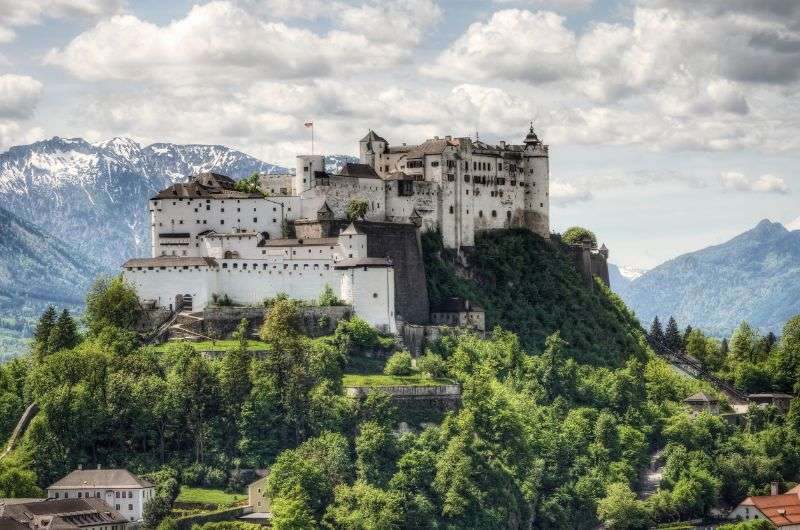
Hohensalzburg Fortress
Now, after soaking in the views from the Museum of Modern Art, you have two options: take the scenic route or the easy way up to Salzburg’s most famous landmark, Hohensalzburg Fortress. I strongly recommend the former.
Option 1: The scenic walk (recommended)
From the Modern Art Museum, I took the 25–to 30-minute stroll through Mönchsberg. It takes you past city walls, forested trails, and hidden lookout points, all leading up to the fortress. This was among my favorite experiences in Salzburg, partially because most people are lazy and take the funicular, so you finally get a chance to enjoy some solitude.
Option 2: The easy way (funicular)
If you're short on time (or energy), the FestungsBahn funicular zips you up in under a minute. You'll find the station at Festungsgasse 4, just past Kapitelplatz in the Old Town. It goes up every 15 minutes or so. (Bonus: It’s free with the Salzburg Card.)
Either way, you’re heading to the biggest medieval fortress in Central Europe, towering over Salzburg since the 11th century.
Pro tip: If I could go back in time, I’d happily skip the paid interior tour—the views from the fortress walls are the main attraction. But I saw it all, so here’s what I learned:
A fortress, not a fairytale castle
Despite its grand, medieval look, Hohensalzburg wasn’t a royal palace. It was built as a defensive stronghold for the prince-archbishops, who ruled both secular and religious affairs in the Holy Roman Empire. These guys had real political power, even controlling the entire Salzkammergut region (the one famous for its stunning lakes, like Lake Hallstatt).
Fun fact: Hohensalzburg fortress was never successfully besieged. Impressive right? Centuries of wars, yet no army managed to conquer it. Turns out the archbishops didn’t even spend much time up here. Instead, they lived in the Residenz Palace in the Old Town, enjoying luxury while the fortress sat there looking impressive.

Must-see areas in the Hohensalzburg fortress
If you do decide to go inside, here are the only parts worth your time:
- Fortress walls & viewpoints—Hands down, the best reason to visit. The panoramic views over Salzburg are breathtaking.
- Reckturm tower—The highest accessible point, offering unmatched views of the Alps and city rooftops.
- The armory room—I liked this, but that’s because I always like a nice armory. It’s one of the few decent exhibits at Hohensalzburg.
- The golden hall & golden chamber—If you like lavishly decorated medieval rooms, these are the most impressive interiors in the fortress.
- The marionette museum—A small but quirky museum showcasing Salzburg’s puppet theater tradition. Not something I need to see again.
Everything else I found pretty underwhelming. Most rooms are empty or filled with exhibits that felt thrown together.
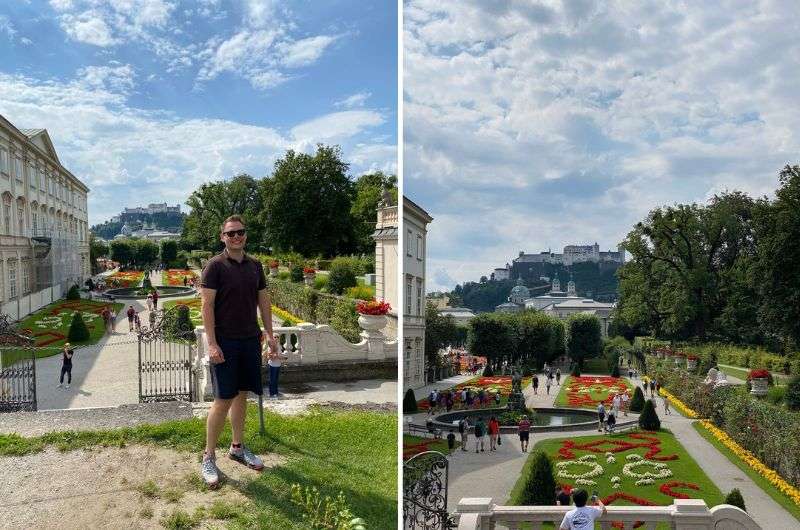
The view of Hohensalzburg from Mirabell Gardens
Storytime—The Ticket fiasco
Once upon a time, a dashing young man set off on a quest to explore Austria’s greatest sights. With his graceful and ever-patient partner by his side, they climbed the mighty fortress, brimming with anticipation for an epic adventure.
Then disaster struck. One ticket went missing.
Thinking it had simply fallen out somewhere, our hero, Jan, bravely retraced his steps to the gate, explaining the situation with a smile and confident diplomacy.
What he encountered, however, was a medieval-level bureaucratic nightmare.
The fortress staff, possibly direct descendants of 11th-century guards, were on a warpath. They refused to help, acted like they didn’t understand English, and turned the whole situation into an absurd drama. It was such a mind-blowingly bad customer service experience that I—someone who never leaves reviews—left a 1-star rating on Google out of sheer frustration.
Is Hohensalzburg worth it?
The fortress itself wasn’t even that impressive inside. The exhibitions were mediocre, with only the armory room being remotely interesting. Sure, the view from the walls was nice, but there are far better viewpoints in Salzburg that don’t require battling fortress guards for entry.
3. Late afternoon: Head over to Hellbrunn Palace to see the trick fountains
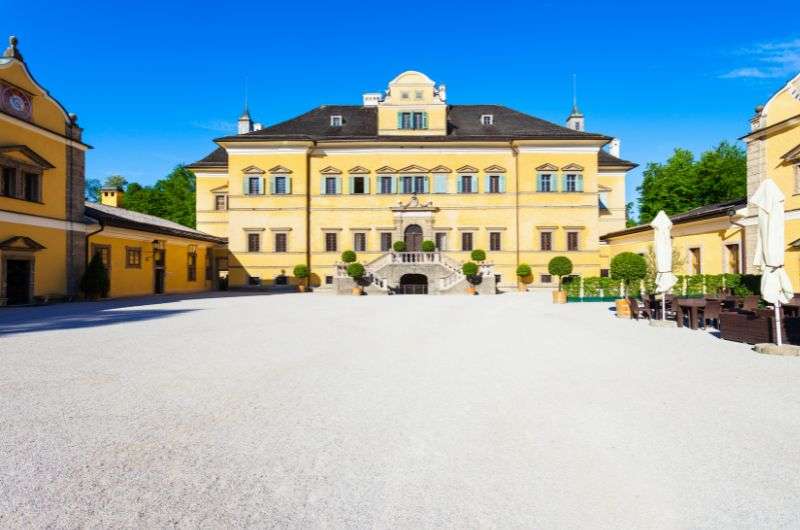
Hellbrunn Palace
After soaking up city views and medieval fortresses, it was time to escape the Old Town and head to Hellbrunn Palace, one of the most unique spots in Salzburg. It’s about 20 minutes from the city center by bus no. 25 (or 13 minutes by car for me), and yes—it’s worth the trip, especially if you’re visiting Salzburg in the summer.
Hellbrunn was built in the early 1600s as a “pleasure palace” for Salzburg’s prince-archbishops. Think party house in the woods—hunting retreats, lavish banquets, and showing off to their aristocratic friends were the main activities.
And then there are the trick fountains.
The highlights of Hellbrunn Palace and gardens:
- Sound of Music fans, take note: The famous gazebo scene where Liesl sings “Sixteen Going on Seventeen” was filmed right here in Hellbrunn’s gardens. You’ll find the glass pavilion in the park. It’s locked (you can’t go inside), but go ahead and dance around it.
- A stone theater with nearly 200 figures powered entirely by water (no electricity!).
- A crown fountain that floats a golden crown up and down using just water pressure.
- Hidden jets were everywhere, including the infamous stone dining table where guests had to sit through surprise soakings while the archbishop stayed dry at the head of the table.
- Cool grottoes and secret passages make it fun to explore the gardens.
- Magnificent well-preserved frescoes and even a unicorn inside the palace!
Why Hellbrunn’s trick fountains are the real reason to visit
The trick fountains are what makes Hellbrunn worth the detour. I walked through the formal gardens and admired the baroque sculptures, but the fountains were where things got fun. And wet. Which is refreshing (unless you’re visiting in the fall)!
This is a collection of fountains and water-based mechanical sculptures with moving figures that are related to Greek and Roman mythology and the history of the Salzburg region.
What’s the trick? You never know where the water will spray from next. There are hidden jets, pop-up fountains, and booby-trapped benches designed to soak unsuspecting guests—just like they did in the 17th century. The archbishop used to drench his visitors on purpose while staying dry himself. (Classic power move.)
Pro tip: If you have more time, Salzburg Zoo is nearby. See below for details.
5. End the day at Hangar-7, a paradise for tech enthusiasts (temporarily closed until May 2025)
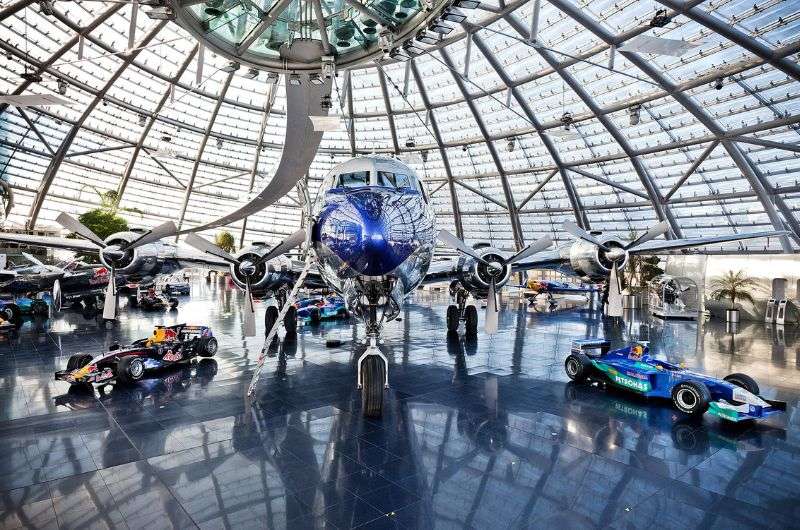
Hangar 7 is so cool!
Note: Hangar-7 and Restaurant Ikarus are undergoing extensive renovations and are closed from January 20, 2025, to the end of May 2025.
Normally, this would be your perfect grand finale after a day in Salzburg. I was able to go before they started to fix it up, but it should be back up and running before summer.
Hangar-7 is located right next to Salzburg Airport, inside a massive, ultra-sleek glass dome packed with airplanes, motorbikes, rally cars, and Formula 1 race cars. It’s what happens when Red Bull’s CEO gets bored and builds a man cave the size of an airport hangar. I was thoroughly entertained!
Apart from the boy-paradise display, there’s also a café and Ikarus restaurant, where Michelin-star chefs rotate monthly. In a nutshell, it’s sort of a something-for-everyone kind of deal.
Fun fact: Hangar-7 operates under the patronage of Red Bull, whose headquarters are in the Salzburg region. The brand's strong association with extreme sports is reflected in the exhibits.
Dinner options in Salzburg:
While Hangar-7 undergoes its 2025 refresh, you can still enjoy exceptional dining experiences in Salzburg. Here are a couple of recommendations:
- Hangar-7 Pop-Up Restaurants: To continue delighting guests during the renovation, two different Hangar-7 pop-up locations will operate from February 1 to April 30, 2025. One will be situated in Getreidegasse and another near Untersberg.
- Steakhouse Meet2Eat: Sometimes, you just want a giant slab of meat, cooked perfectly, and maybe a beer that doesn’t come in a crystal glass. That’s Meet2Eat—nothing fancy, no tiny portions, just quality steaks, grilled exactly the way they should be.
- The Glass Garden: If you’re after panoramic views and don’t mind paying for them, this place could be your dinner spot. It’s one of those places where they serve food that looks like art and where you’ll wonder if you’re supposed to eat it or frame it.
- Casino Restaurant Salzburg: Dinner in a baroque palace, followed by a chance to lose money at the roulette table. The food is surprisingly good (not just casino snacks), and the whole experience feels very James Bond, minus the tuxedo.

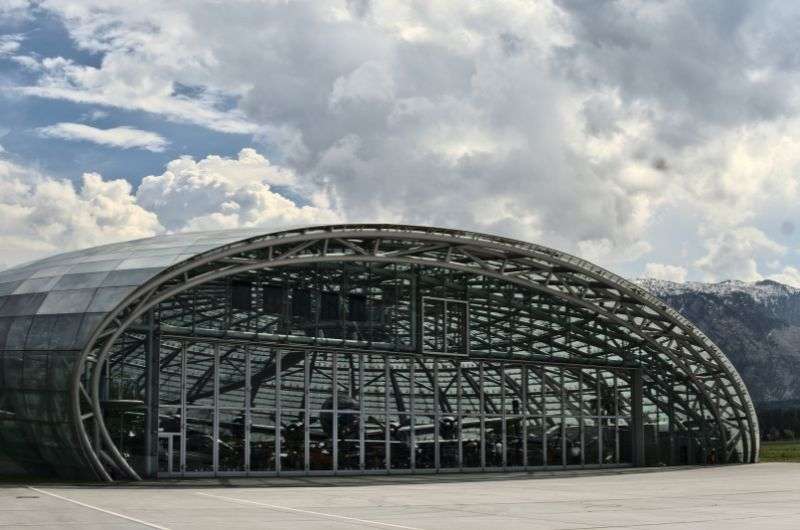
Hangar-7: A futuristic glass dome packed with planes, race cars, and fine dining
Have more time? Here’s what else to see in Salzburg
If you have an extra half day in Salzburg, or you just want to swap out something from this itinerary, here are a couple more places I thought were worth checking out. Don’t worry; these ones are actually fun, not just “fillers.”
Salzburg Zoo: not just for kids!
Salzburg Zoo is just a 15-minute walk from Hellbrunn Palace. It’s located at the foot of Hellbrunn Mountain, partly inside the forest, which makes it one of the more scenic zoos you’ll visit.
What to expect:
- Over 1,200 animals from 140 species, including rare snow leopards (Irbis).
- The enclosures are spacious, and the zoo uses the natural rock face of the mountains as part of the animal habitats.
- It's fun for families, but even without kids, it’s a nice walk and a relaxing way to spend an hour or two before heading back to the city. Heck, I probably prefer it to Mirabell Gardens.
Stiegl-Brauwelt: Salzburg’s beer experience
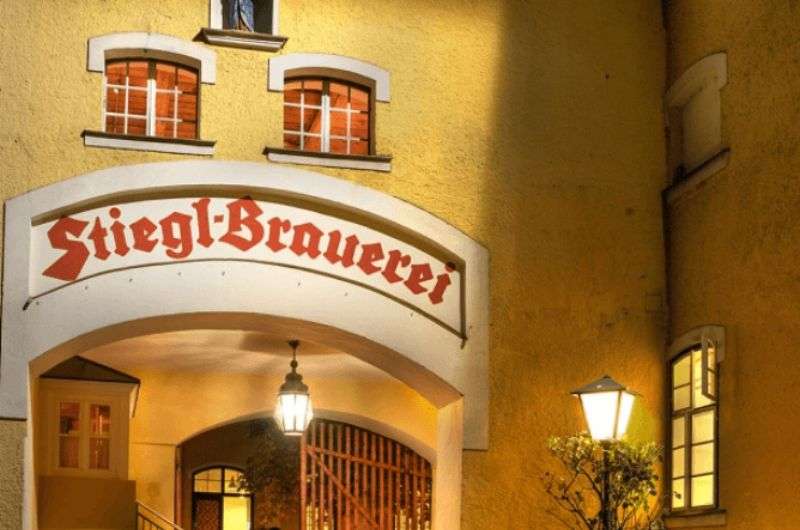
Stiegl-Brauwelt Beer Museum was awesome!
Just what I was looking for on my Austria trip—a beer experience! Now, Austrian beer isn’t exactly world-famous (unless you count Ottakringer, which is... fine), and if you’re Czech like me, you already know who makes the best beer. But Stiegl-Brauwelt was a pretty decent surprise.
It’s located in Maxglan, just outside Salzburg’s Old Town. Stiegl-Brauwelt is more than just a brewery tour; I was fully immersed in beer (ok, not like I was swimming in it, but you get what I mean).
It has everything from a movie explaining the history of Stiegl to a beer-tasting cellar to exhibits that let you see, touch, and smell every stage of the brewing process. Simply put, it’s not just boring reading plaques and staring at things the whole time.
- Your ticket includes three beer tastings plus a tasting glass to take home.
- They’ve got a huge beer garden in the summer, and it’s a great place to stuff your face with classic Austrian beer snacks—pretzels, sausages, schnitzels, you name it.
- And yes, I still think Czech beer is way better, but if Salzburg’s as boring as it sometimes feels, at least this place is a winner.
Very fun fact: Stiegl has been brewing beer since 1492—the same year Columbus stumbled into the Americas. While he was out there “discovering” things, Salzburg had its priorities straight and was busy perfecting liquid bread.
In the Middle Ages, people of all ages (even children) drank beer daily, especially small beer, for hydration because water sources were frequently contaminated, especially in urban areas. In many European cities, including Salzburg, beer (and other fermented drinks like wine and cider) was a dietary staple because it was often safer to drink than water.

Even though Salzburg is not my favorite city, it's still one of the top cities of Austria!
Is one day enough for Salzburg?
Yes, it's possible to experience the essence of Salzburg in a single day. The city's compact size and well-planned layout allow visitors to see major attractions like Mirabell Gardens, the Old Town, and Hohensalzburg Fortress within a day.
How walkable is Salzburg?
Salzburg is incredibly walkable. The city center is compact, with most major attractions within a 25–30 minute walk of each other. From the train station, it's about a 10-minute walk to Mirabell Gardens and 25 minutes to reach Hohensalzburg Fortress, making it easy to explore the city's highlights on foot.
What is the famous dessert in Salzburg?
Salzburg is famous for Salzburger Nockerl, a sweet, fluffy soufflé-like dessert that’s as much a local legend as it is a sugar bomb. It’s made from whipped egg whites, sugar, and a little flour, then baked until golden brown. Traditionally, it’s served warm, sprinkled with powdered sugar, and often comes with a berry compote on the side.
Fun fact: The three golden peaks of Salzburger Nockerl are said to represent the three mountains surrounding Salzburg—Mönchsberg, Kapuzinerberg, and Gaisberg.
You might also be interested in reading:
- The Ultimate 10-Day Austria Itinerary
- One Perfect Day in Hallstatt
- What is Austria Known For? 13 Tips and Tricks for Your Vacation
- 9 Unusual Things to Do in Vienna
- 7 Best Cities and Towns to Visit in Austria
Sometimes, all you need to do is take the first step... I've filtered out the best hotels in Salzburg for you
Save it for yourself to come back to later, or share with your friends on social media!
This post may contain affiliate links. We earn a small commission if you make bookings through my links at no additional cost to you. This helps us keep this blog free, thank you!





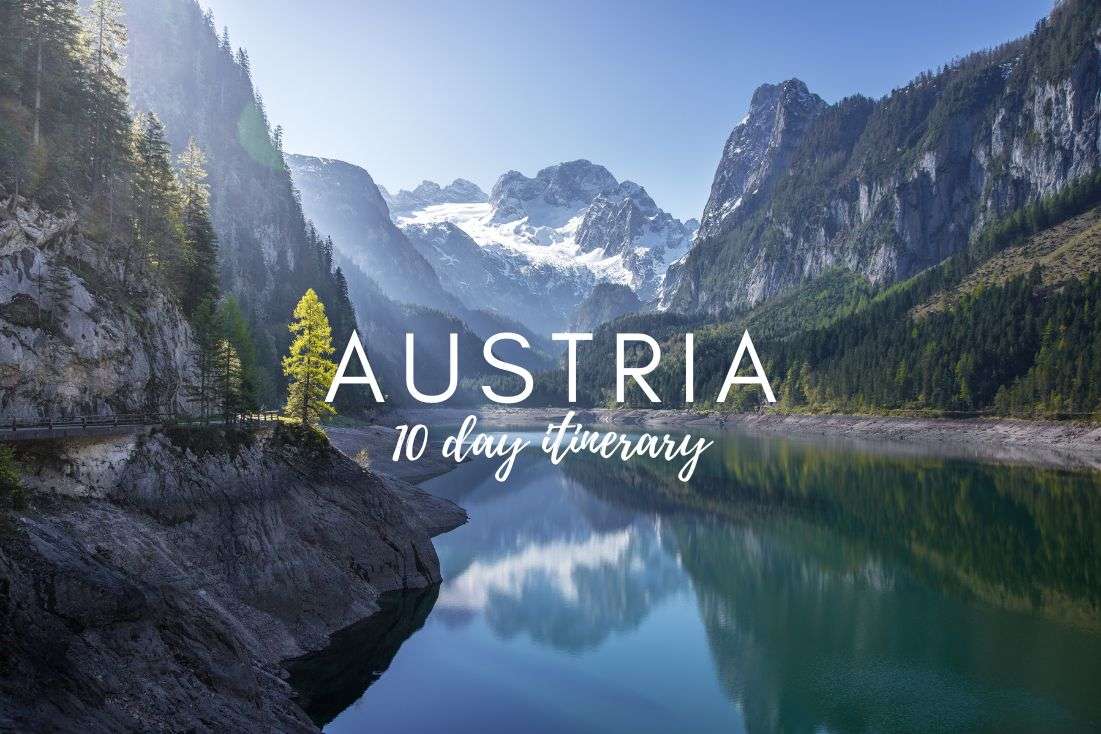
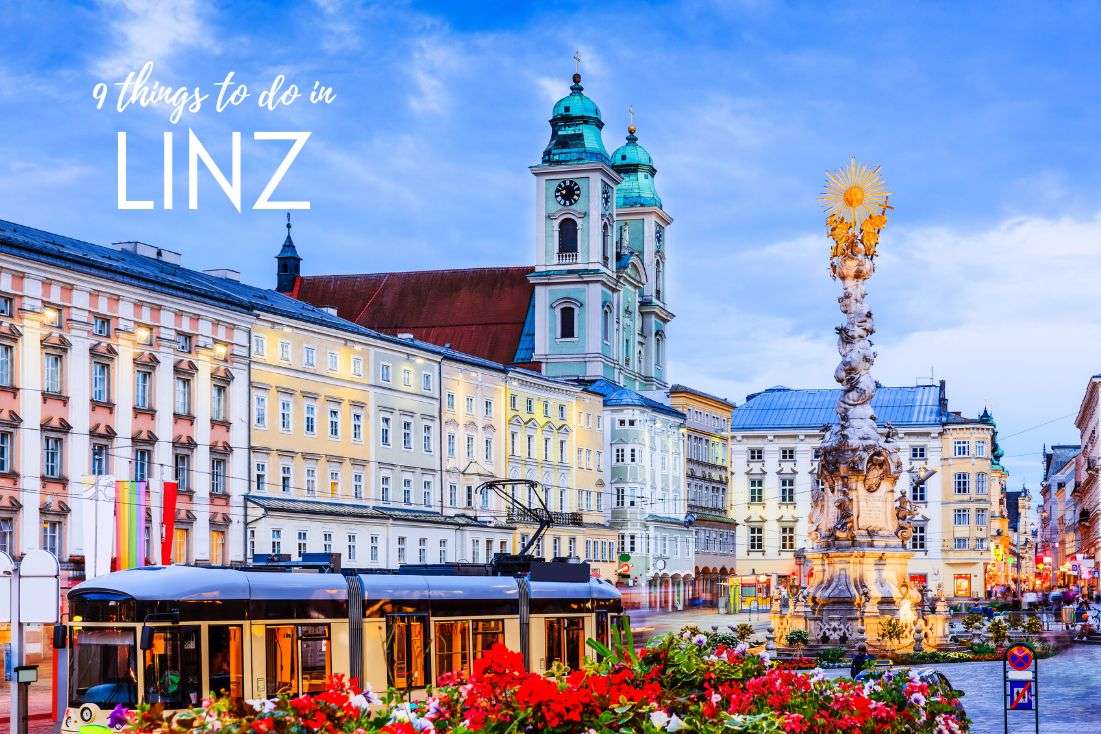



Comments | Thoughts? Give us a shout!